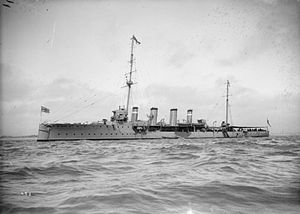 Boadicea at anchor
| |
| History | |
|---|---|
| Name | Boadicea |
| Namesake | Boadicea |
| Builder | Pembroke Royal Dockyard |
| Laid down | 1 June 1907 |
| Launched | 14 May 1908 |
| Completed | June 1909 |
| Out of service | 18 February 1920 |
| Fate | Sold for scrap, 13 July 1926 |
| General characteristics | |
| Class and type | Boadicea-class scout cruiser |
| Displacement | 3,350 long tons (3,400 t) (normal) |
| Length | 405 ft (123.4 m) (o/a) |
| Beam | 41 ft 6 in (12.6 m) |
| Draught | 14 ft (4.3 m) |
| Installed power |
|
| Propulsion |
|
| Speed | 25 knots (46 km/h; 29 mph) |
| Complement | 317 |
| Armament |
|
| Armour |
|
HMS Boadicea was the lead ship of her class of scout cruisers built for the Royal Navy in the first decade of the 20th century. She led the 1st Destroyer Flotilla from completion until the ship was transferred to the 3rd Destroyer Flotilla in mid-1912. A year later Boadicea was reassigned to the 2nd Battle Squadron and she spent the bulk of World War I with that squadron. The ship was present at, but did not fight in, the Battle of Jutland in mid-1916. Boadicea was converted into a minelayer at the end of 1917 and made three sorties to lay her mines before the end of the war. She was placed in reserve after the war and taken out of service in 1920. The ship was used for harbour service at Dartmouth until she was sold for scrap in 1926.